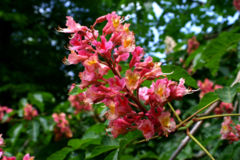Red Horsechestnut: Difference between revisions
m moved Aesculus X carnea to Aesculus × carnea |
No edit summary |
||
| Line 1: | Line 1: | ||
{{SPlantbox | {{SPlantbox | ||
|familia=Hippocastanaceae | |familia=Hippocastanaceae | ||
|genus=Aesculus | |genus=Aesculus | ||
|species= | |species=x carnea | ||
|common_name=Red horse chestnut | |common_name=Red horse chestnut | ||
|name_ref=Flora - A Gardener's Encyclopedia | |name_ref=Flora - A Gardener's Encyclopedia | ||
| Line 13: | Line 13: | ||
|Max wd metric=ft | |Max wd metric=ft | ||
|width_ref=Flora - A Gardener's Encyclopedia | |width_ref=Flora - A Gardener's Encyclopedia | ||
|poisonous=seeds slightly toxic | |||
|lifespan=perennial | |lifespan=perennial | ||
|life_ref=Flora - A Gardener's Encyclopedia | |life_ref=Flora - A Gardener's Encyclopedia | ||
| Line 25: | Line 26: | ||
|usda_ref=Flora - A Gardener's Encyclopedia | |usda_ref=Flora - A Gardener's Encyclopedia | ||
|max_zone=9 | |max_zone=9 | ||
|image= | |sunset_zones=1-10, 12, 14-17, 32-45 | ||
|image=Aesculus carnea BotGartenMuenster PurpurKastanie 6685.jpg | |||
|image_width=240 | |image_width=240 | ||
}} | }} | ||
'''''Aesculus × carnea''''' is a hybrid between the [[Red Buckeye]] (''A. pavia'') and the Common [[Aesculus hippocastanum|Horse-chestnut]] (''A. hippocastanum''). The origin of the tree is not known, but it is probably a chance garden hybrid, appearing in [[Germany]] before 1820. The hybrid is a medium-size tree to 20-25 m tall, intermediate between the parent species in most respects, but inheriting the red flower color from ''A. pavia''. It is a popular tree in large gardens and parks, most commonly the selected cultivar 'Briotii' (named in 1858 to honor Pierre Louis Briot, the nurseryman at Trianon-Versailles near Paris, France), which has 10-inch tall, deep rosy flowers and matures as a smaller tree. Other cultivars are 'O'Neil',which produce larger (10-12 inch), brighter red flowers, '[[Fort McNair]]' (named from where it was selected), which has dark pink flowers with yellow throats and resists leaf scorch and leaf blotch, and 'Plantierensis', which has intense rose pink flowers with yellow throats and does not set fruit, which makes it less messy.<ref>{{cite book | |||
| last = Roth | |||
| first = Susan A. | |||
| authorlink = | |||
| coauthors = | |||
| title = Taylor's guide to trees | |||
| publisher = Houghton Mifflin Harcourt | |||
| date = 2001 | |||
| location = Boston, MA | |||
| pages = 408 | |||
| url = http://www.amazon.com/gp/product/0618068899 | |||
| doi = | |||
| id = | |||
| isbn = 9780618068890}}</ref> | |||
==Cultivation== | ==Cultivation== | ||
Revision as of 20:24, 20 November 2010
| Aesculus x carnea subsp. var. | Red horse chestnut | |||||||||||||||||||||||||||||||||||||||||||||||||||||||
|---|---|---|---|---|---|---|---|---|---|---|---|---|---|---|---|---|---|---|---|---|---|---|---|---|---|---|---|---|---|---|---|---|---|---|---|---|---|---|---|---|---|---|---|---|---|---|---|---|---|---|---|---|---|---|---|---|

|
|
| ||||||||||||||||||||||||||||||||||||||||||||||||||||||
| ||||||||||||||||||||||||||||||||||||||||||||||||||||||||
Aesculus × carnea is a hybrid between the Red Buckeye (A. pavia) and the Common Horse-chestnut (A. hippocastanum). The origin of the tree is not known, but it is probably a chance garden hybrid, appearing in Germany before 1820. The hybrid is a medium-size tree to 20-25 m tall, intermediate between the parent species in most respects, but inheriting the red flower color from A. pavia. It is a popular tree in large gardens and parks, most commonly the selected cultivar 'Briotii' (named in 1858 to honor Pierre Louis Briot, the nurseryman at Trianon-Versailles near Paris, France), which has 10-inch tall, deep rosy flowers and matures as a smaller tree. Other cultivars are 'O'Neil',which produce larger (10-12 inch), brighter red flowers, 'Fort McNair' (named from where it was selected), which has dark pink flowers with yellow throats and resists leaf scorch and leaf blotch, and 'Plantierensis', which has intense rose pink flowers with yellow throats and does not set fruit, which makes it less messy.[1]
Cultivation
Propagation
Pests and diseases
Varieties
Gallery
-
photo 1
-
photo 2
-
photo 3
References
- ↑ Roth, Susan A. (2001). Taylor's guide to trees. Boston, MA: Houghton Mifflin Harcourt. pp. 408. ISBN 9780618068890. http://www.amazon.com/gp/product/0618068899.
External links
- w:Red Horsechestnut. Some of the material on this page may be from Wikipedia, under the Creative Commons license.
- Red Horsechestnut QR Code (Size 50, 100, 200, 500)
